CHAPTER 12
DAMAGE CONTROL
Damage control is the responsibility of ALL
HANDS, from the commanding officer to the newest
recruit.Without proper damage control training, your
shipmatesmaybeinjuredorkilled,orperhapsyourship
may sink. DuringWorldWarII, many ships were saved
because of the positive damage control practices.
For instance, the German battleship Bismarck was
kept afloat and remained inafighting status for an
extended period in spite of the British pounding it with
heavy gunfire.Youcan see that survivability through
positive damage control is not only important for the
United States, but on an international level.
Effective damage control (DC) requires the correct
useofequipmentand techniques to prevent or minimize
the damage effects caused by battle,fire, collision,
grounding,explosion, and so forth. DC also includes
defensive measures used to reduce the effects of
weapons of mass destruction, such as chemical,
biological,andradiological(CBR)warfare.Remember,
our Navy gives you the best damage control training in
the world. As a ship’s crew member, it’s your
responsibility to properly safeguard yourself and your
ship. You learn how to do this through training.
Youmayfeel the information inthischapterdoesn’t
apply to you because of your chosen occupationalfield.
Remember that asaSailor, no matter what your rating,
you may serve aboard ship at any point in your career.
Therefore, asacrew member, you must know your
damage control responsibility. For more in-depth
information about the administration and organization
of damage control, you should refer to the following
manuals:
•
Surface Ship Survivability, Naval Warfare
Publication (NWP) 3-20.31
•
Naval Ship’s Technical Manual (NSTM), chapter
079, vol. 2, “Practical Damage Control”
•
Naval Ship’s Technical Manual (NSTM), chapter
555, vol. 1, “Surface Ship Firefighter”
Our Navy hasacomplete organization in place
relating to damage control. This organization consists
of the following two main parts:
1. The administrative organization, and
2. The battle organization.
ADMINISTRATIVE ORGANIZATION
Learning Objectives: When youfinish this chapter,
you will be able to—
• Identify the chain of command within the
damage control administrative organization.
•
Recognize the functional purpose of each part of
the organization and the interrelationships
between the parts.
The damage control administrative organizational
chain of command is shown infigure 12-1. As you can
see, the responsibility for damage control begins with
thecommanding officer (CO) ofanaval ship andruns to
the most junior Sailor in the DC division and damage
control petty officer community.
Look atfigure 12-1. As you can see at the level of
the ship’s damage control assistant (DCA), other
personnel report to the DCA. Each person has a
different administrative responsibility and tasking.
Each person reports back up the chain via the DCA.
PURPOSE OF ADMINISTRATIVE
ORGANIZATION
The administrative organization requires the
efforts of all hands to establish and maintain material
readiness conditions. Material readiness is
12-1
…theevents of 14-15 April 1988 have proven that solid damage
control, good training, andsoundleadership basedonexperiencecan
save a ship that is on fire and sinking, to fight another day.
—Paul X. Rinn, CAPT
CO, USS Samuel B. Roberts (FFG-58)

accomplished when DC fittings and equipment
aboard ship are available and in properworking order
to combat any emergency. Aboard ship, there is a
damage control petty officer (DCPO) for each
department or division. The DCPO makes sure that all
emergency equipment andfittings are maintained and
work properly. The DCPO also maintains the
compartment checkoff list.
Eachshiphasaspecifiednumberof damage control
lockers witharepair party assigned. Repair parties and
repair locker personnel, along with the DCPOs, receive
periodic training so they can perform their assigned
duties. The engineer officer is responsible for
maintaining properly trained DCPOs, repair parties,
and repair locker personnel. Under the engineer officer,
the DCA coordinates the efforts of the repair parties to
control damage. Also, the DCA oversees all DC
training. When properly maintained, the administrative
organization reduces and confines any initial damage.
The survivability ofaship depends on the level of
preparedness of its personnel. The condition of the
equipment, shipboard systems, and the amount of
training arefactors that affect the ship’s survivability.
Ship’s bills, records and schedules for maintenance,
written doctrine, and procedures relating to damage
control are all part of the administrative organization of
damage control.
For the list of responsibilities forvarious ship’s
personnel, refer to OPNAVINST 3120.32, or ask your
LPO or LCPO.
12-2
Student Notes:
DAMAGE CONTROLMAN
CHIEF/SENIOR/MASTER
DC DIVISION PERSONNEL
DAMAGE CONTROL
CENTRAL
CONTROL STATION
SPACE SUPERVISOR
COMMANDING
OFFICER
ENGINEER OFFICER
and
DAMAGE CONTROL OFFICER
DAMAGE CONTROL
ASSISTANT
GAS FREE
ENGINEER
SHIP’S
FIRE MARSHAL
EXECUTIVE
OFFICER
DAMAGE CONTROL
TRAIN TEAM
DAMAGE CONTROL
PETTY OFFICERS
FIRE PREVENTION
BMRf1201
Figure 12-1.—Administration organization chain of command.

COMMANDING OFFICER
United States Navy Regulations states thevarious
broad responsibilities of the commanding officer (CO).
These regulations require the commanding officer to
maintain his/her command in a state of maximum
effectiveness forwar. They also require that he/she
repair as much damage as possible immediately after a
battle or action.
To carryoutthis charge,the COmustensure thatthe
ship’s officers and crew are trained and continually
exercised in all aspects of survivability. The CO should
be fullyaware of the adequacy and operability of all
survivability systems and equipment. Shortages and
deficiencies must not be tolerated, and they should be
immediatelyrectified(fixed)or reportedascasualtiesin
the ready reporting system.
EXECUTIVE OFFICER
Theexecutive officer (XO)keeps the command
informed of the ship’s survivability readiness. The XO
carries out the requirements regarding the ship’s
survivability training, the readiness to manage
casualties,andthereadiness to control and recoverfrom
damage. As the team leader, the XOis the senior person
assigned to the damage control training team (DCTT).
The DCTT is responsible for all shipboard drills and
exercises in the area of damage control.
DAMAGE CONTROL TRAINING TEAM
Each ship hasaDCTT. The DCTT trains the ship’s
DC organization in ship equipment, ship systems, and
procedures and techniques relating to the ship’s
survivability. The DCTT is organized to train all types
of DC-related exercises.
The DCTTevaluates and critiques the DC team’s
abilities as well as theirown. The team is made up of a
variety of ratings, which provides the ship withawide
range ofexperience.All team members are qualified, as
a minimum, to at least the level of personnel they are
training and/or evaluating.
ENGINEER OFFICER
The engineer officer is designated as the ship’s
damage control officer. The ship’s engineer officerfills
the billet as the department head of the engineering
department, and the DC division is one of the divisions
in that department. The engineer officer has the
following responsibilities:
•
The operation, care, and maintenance of the
main propulsion plant, auxiliary machinery, and
piping systems
•
The control of damage
•
Theoperationandmaintenanceofelectric power
and distribution systems
•
Repairs to the hull
•
Repairs to material and equipment in other
departments that require the attention of
engineering department
Also the damage control officer (DCO), the
engineerofficer reviews all administrative items drafted
by the DCA and DCA personnel. This isaprimary
administrative duty that occurs before items are routed
to the CO for approval.
DAMAGE CONTROL ASSISTANT (DCA)
The DCA is the primary assistant to the damage
control officer in the areas of damage control;
firefighting; and chemical, biological, and radiological
defense.Forthepurpose of administrative organization,
the DCA is in charge of many programs relating to
damage control on the ship and monitors the
effectiveness of other programs.
The DCA is responsible for the overall
administration and training of the ship’s DC
organization. Under the guidance of the DCA,
individualdepartmentsanddivisionsareresponsiblefor
administrationand training as related to damage control
for their personnel. All ships afloat must meet the
minimum prescribed formal training requirements to
include training for the following personnel:
12-3
Student Notes:

•
All DCTT members
•
In-port emergency teams (IETs)
•
Rescue and assistance (R&A) detail
•
Repair party personnel
•
Damage control petty officer (DCPO)
organization
•
All hands
Shipboard training by the DCTT is scheduled,
executed, and documented to meet the type
commander’s (TYCOM’s) requirements. The DCA
maintains records of all DC personnel qualification
standards (PQS) accomplishment for all hands.
All ship’s instructions relating to casualty
prevention and response are either drafted by or drafted
for and reviewed by the DCA. This review is made
before seeking the approval and signature of the ship’s
CO. The DCA is the residentexpert for the engineer
officer and the command on instructions relating to
casualty prevention and response. The DCA
administers the following billets and programs: DCPO,
gas free engineer (GFE), fire marshal and fire
prevention, and the operation of damage control central
(DCC) and supporting watches.
DAMAGE CONTROL DIVISION
The damage control division is responsible for the
damage control systems and equipment on board ship.
The DCA is the senior member (division officer) of the
DC division. As such, the DCAoversees all the paper
work and the scheduling for maintenance of these
systems and equipment.
Damage Control Petty Officer (DCPO)
A petty officer, who has completed the PQS, is
designated as the damage control petty officer (DCPO)
based on TYCOM instructions. Eachwork center has a
DCPO. Division officers nominate DCPOs for
endorsement by the chain of command. The XO gives
thefinal approval for the nomination, replacement, and
rotation of all DCPOs. DCPOs normally serve for a
periodof6months; they checkwith thefiremarshaland
DCA whenfirst assigned to or relieved from this duty.
The DCPO is responsible for—
•
Acquainting themselves with all phases of the
ship’s damage control,firefighting, and defense
procedures
•
Assisting with the instruction of division
personnel in damage control
•
Firefighting, egress, and CBR procedures
•
Ensuring the preparation and maintenance of
damage control checkoff lists for all spaces
under their cognizance
•
Supervising the setting of specified damage
control material conditions within division
spaces and making all required reports
•
Weighing portable CO
2
bottles, inspecting and
testing damage control and firefighting
equipment, and preparing all requiredreports for
approval of the division officer based on current
ship’s instructions and planned maintenance
system (PMS) requirements
• Ensuring all battle lanterns, dog wrenches,
spanners, and other damage control equipment
are in place and inausable condition in all
division spaces
•
Ensuring all compartments, piping, cables, and
damage control equipment are properly
stenciled or identified by color codes based on
NSTM, chapter 079, volume 2, and General
Specifications for Ships of the United States
Navy, NAVSEA S9QQO-AA-SPN-010/
Gen-Spec, chapters 505, 507, and 602
•
Ensuring the posting of safety precautions and
operating instructions in required division
spaces
•
Assisting the division officer in inspection of
division spaces for cleanliness and preservation
and assisting in the preparation of required
reports
12-4
Student Notes:

•
Conducting daily inspections of division spaces
for the elimination of fire hazards
•
Performing any other actions in regard to
damage control and maintenance of spaces that
are directed by the division leading petty officer,
division officer, fire marshall, DCA, and
executive officer
Gas Free Engineer (GFE)
Thegasfree engineer (chief petty officer or above)
decides when it’s safe for personnel to enter closed or
poorlyventilated spaces. The GFE makes sure that all
necessary measures have been taken to eliminate the
risk offire,explosion,exposure to toxic substances,
suffocation, or asphyxiation. The GFE hasaworking
knowledge of all definitions, instruments, and
equipment listed in the GFE program. The shipboard
GFE meets the qualifications and is capable of
performing the duties and responsibilities specified in
NSTM, chapter 074,volume 3, “Gas Free Engineering.”
All Navy ships must be adequately staffed with
personnel qualified to performgasfree engineering
services for normal and emergency situations.
Fire Marshal
All ships designateafire marshal to assist the
engineer officer. Thefire marshal helps the DCA train
personnel to prevent andfightfires. The ship’s fire
marshal and dutyfire marshals are qualified to ensure
continuity of inspections for improperly stored or
inoperative DC equipment. Fire marshals are free of
duties thatwould not let them instantly respond to
emergencies. The fire marshal conducts daily
inspections throughout the ship, paying particular
attention to the following areas:
•
Housekeeping
•
Firefighting equipment, both portable and fixed
•
Safety precautions
•
Flammable liquids
•
Smoking
•
Welding and burning
•
Stowage of compressed gas
•
Fume/spraytight light covers
•
Grease filters/traps, Gaylord hoods
•
Ventilation/air conditioning ducts/flammable
stowage ventilation
•
Material condition
Thefiremarshalhasthefollowingresponsibilities:
•
Submitting reports citing fire hazards and
making recommendations for correction
NOTE
Immediate steps should be taken to
eliminate hazards resulting from poor
housekeeping, welding or burning,
smoking, and equipment deficiencies.
Thefire marshal submits discrepancy
reports to the DCA with copies to the
XO and the appropriate department
head(s) and conducts follow-up
inspections to ensure compliance.
• Conducting training forfire teams, rescue and
assistance teams, and departmental/divisional
DCPOs stressing fire hazard consciousness
•
Setting up a fire watch team before
regular/interim overhauls or availabilities
•
Training and assigning fire watches
•
Beingoverall in charge at thefire scene until
relieved byageneral quarters (GQ) scene leader
andkeeping DCC and/or the OOD informed
with an accurate status of the situation
12-5
Student Notes:

REVIEW 1 QUESTIONS
Q1. The damage control organization is divided into
what two main parts?
a.
b.
Q2. What is the purpose of the administrative phase
of DC?
Q3. Who is responsible to maintain properly trained
DCPOs, repair parties, and repair locker
personnel?
Q4. Who is the senior person assigned asteam leader
on DCTT?
Q5. What person is responsible for making sure that
all battle lanterns, dog wrenches, spanners, and
other damage control equipment are inplace and
in a usable condition within their division?
Q6. Before anyone can enter a poorly ventilated
spaceorvoid,whomustcertifythespaceassafe?
BATTLE ORGANIZATION
Learning Objectives: When youfinish this chapter,
you will be able to—
•
Recognize the battle organization of damage
control parties.
•
Recall the location and contents of shipboard
damage control lockers.
The battle phase starts when the ship has received
actual damage. The DCA coordinates the efforts of the
repair parties from damage control central (DCC).
These efforts may include fighting fires, flooding,
controlling the ship’s stability, and repairing battle
damage. Repair party personnel also use CBR defense
measures (CBR is covered in chapter 13).
PURPOSE OF THE BATTLE
ORGANIZATION
Once the shiphas been damaged, theship’s damage
control battle organization is responsible for restoring
the ship to as near normal operation as possible. The
organizationvaries somewhat from one ship to another,
depending on the size, type, and mission of the ship.
However, the same basic principles apply to all battle
organizations.
The DCA isresponsible, under theengineer officer,
for the ship’s survivability systems. The DCA’s
responsibilities include control of damage; control of
stability, list, and trim;fightingfires; restoration from
damage; medical casualty response; and CBR
countermeasures. The battle station for the DCA is
DCC. The primary damage control battle organization
units are repair parties or teams. Battle dressingstations
(satellite medical stations) should be located near the
repair parties.
DAMAGE CONTROL CENTRAL/CENTRAL
CONTROL STATION
The primary purpose of damage control central
(DCC) is to collect and compare reports fromvarious
repair stations to determine the ship’s condition and the
corrective action to be taken. DCC is the nerve center
and directing force of the entire damage control
organization. Personnel from various shipboard
divisions man DCC. On newer class ships, the central
point for reporting is the central control station (CCS).
The CCS has the added capability of being able to
control the closing offire zone (FZ) doors and certain
valves electronically. Also, CCS can remotely activate
fire-fighting systems.
12-6
Student Notes:

Reports from the repair parties are carefully
checked in DCC/CCS. This is done so that immediate
action can be taken to isolate damaged systems and to
make effective emergency repairs. As reports are
received, graphic records of the damage are made on
damage control diagrams and status boards under the
direction of the DCA.Forexample, reports on flooding
are used to update the status boards showing the liquid
distribution (fuel and water) before the damage
occurred. With this information, the stability and
buoyancy of the ship can be estimated and necessary
corrective measures taken.
In the unlikelyevent DCC/CCS is destroyed or is
unable to retain control,aplan is in place to designate
repair stations to take over the responsibilities of
damage control central.
REPAIR PARTIES
The following chart shows a variety of repair
lockersthat are found on an aircraft carrier. All ships
have a minimum of repair lockers 2, 3, and 5. Each
lockerhas anofficeror senior petty officerincharge.
The makeup of each repair party in these lockers
dependsonthetypeofshipandtheareatheyserve.
Repair Party Personnel
For a repair party to control battle damage
effectively, PQS-qualified personnel are assigned to
specificfunctions and duties. Some personnel may have
more than one assignment, depending on the number
and qualifications of personnelavailable. Repair party
personnel must know theirownarea of responsibility
along with the areas of other repair parties. The
following functions are common to all repair parties:
•
Make repairs to electrical and communication
circuits and rig casualty power.
•
Give first aid and transport injured personnel to
battle dressing stations without seriously
reducingtheparty’s damagecontrolcapabilities.
•
Detect, identify, and measure radiation dose and
dose rate intensities.
•
Decontaminate the affected areas of nuclear,
biological, and chemical attacks.
•
Identify, control,andextinguishalltypesoffires.
•
Control and remove flooding water.
•
Evaluate and correctly report the extent of
damage in the repair parties’ area of
responsibility, to include maintaining—
— Deck plans showing location of CBR
contamination, location of battle dressing
stations, casualty collection and
decontamination stations, and safe routes to
them.
— Graphic display boards showing damage
and action taken to correct disrupted or
damaged systems, using standard DC
symbology and plotting techniques.
•
Make emergency repairs to various piping
systems.
•
Be familiar with all damage control fittings in
the assigned area, such as watertight doors,
hatches, scuttles, ventilation systems, and
various valves.
•
Control and clean up hazardous material spills.
12-7
Student Notes:
Repair Locker Location or Function
Repair 1 Main deck repair
Repair 2 Forward repair
Repair 3 After repair
Repair 4 Amidships repair
Repair 5 Propulsion repair
Repair 6 Ordnance
Repair 7 Gallery deck and island structure
Repair 8 Electronic casualty control

In-Port Emergency Team (IET)
In-port emergency teams are made up of duty
section personnel. IET members are emergency team
member qualified and stand ready to respond to any
type of casualty.
At times, it may be necessary to provide additional
personnel and material support to the IET. These
additional personnel come fromapool ofexcess duty
personnel and assemble atadesignated location. They
can assist in settingfire or flooding boundaries and are
available to back up the primary IET, if needed.
Rescue and Assistance (In Port/At Sea)
All ships are required to have a rescue and
assistance detail in port and at sea. The primary
missions of this detail are to rescue personnel at sea,
assist another unit in distress, and assist persons or
activities in distress ashore. All personnel assigned to
the rescue and assistance detail must, asaminimum, be
qualifiedasanemergencyteammemberandinfirstaid.
Rapid Response Team
When in port or under way, each ship has a
designated rapid response team. This team proceeds
directly to the scene whenafire or flooding is called
away. The team attempts to quickly extinguish or
contain thefire or minimize or stopaflooding. At a
minimum, this team is made up of four personnel
qualified as fire team members and the ship’s fire
marshal. Because immediate response is required,
protective clothing or OBAs aren’t donned. If they are
unable togain control of the casualty withinapreset
time frame,afull IET or GQ team relieves them and
takes over.
General Quarters (GQ)
General quarters is an all handsevolution. It is the
highest state of readiness of the ship, and all repair
lockers are manned and fully equipped to combat
casualties. When responding to GQ, all hands adjust
their clothing to battle dress and proceed to their GQ
stations.
Battle dress—Bottom of pants tucked into boots or
socks, long sleeves pulled down and buttoned, top
button on shirtbuttoned, and flash hood and gloves
donned. All exposed skin covered.
GQ route—Move forward in passageways and up
ladders on starboard side, move aft in passageways and
down ladders on port side. Since all hands will be
moving at the same time, you have to move with the
flow of traffic.
DAMAGE CONTROL LOCKERS
The equipment and materials required for making
battledamage repairsvary according to the natureof the
damage. Since many different kinds of damage can
occur aboard ship, you must know how to useavariety
of equipment and materials.
Checks should be made to see that all damage
control equipment tools and materials on the allowance
list are actually on board and in working order.
Comparing the ship’s allowance list with an accurate
and up-to-date inventory of onboard damage control
equipment does that.
Damage control equipment should be stowed or
installed in its designated location and be readily
accessible. Emergencies can be handled much more
effectively if equipment isavailable than if you have to
waste time looking for it.
Damage control equipment must not be used for
any purpose other than damage control. Because
damage control equipment is located throughout the
ship, some people are tempted to use it merely because
it is handy. That must not be allowed. It is important to
make all hands realize their lives may literally depend
onthereadyavailability of damage control equipmentif
an emergency should arise.
REVIEW 2 QUESTIONS
Q1. When does the battle phase of damage control
start?
12-8
Student Notes:

Q2. Where is the battle station for the DCA?
Q3. During GQ, DCC receives reports and casualty
status from—
Q4. What is the minimum requirement to be a
member of the in-port emergency team?
Q5. What are the primary missions of the rescue and
assistance team?
Q6. What is the ship’s highest state of readiness?
COMMUNICATIONS
Learning Objectives: When youfinish this chapter,
you will be able to—
•
Identify the communications devices used
during damage control evolutions.
•
Recognize the purpose of communications
devices used during damage control evolutions.
Communications are vital to the damage control
organization.Without good communications, the entire
organization could break down andfail in its primary
mission. The size and complexity of the surface ships
govern the design of DC communications systems
found aboard ship. Major shipboard DC
communications systems are as follows:
NOTE
All the systems listed below areexplained in
detail in chapter 4 of this TRAMAN.
•
Sound-powered telephones
•
IVCS
•
Ship’s service telephones
•
Announcing systems
•
Intercommunications systems
•
DC WIFCOM
EMERGENCY COMMUNICATIONS
The X40J is an emergency damage control
communication system. It’s employed in theevent of
primary, auxiliary, and supplementary communications
circuitfailure. The X40J is composed of both portable
(“salt and pepper” line) and permanently installed
(risers) components.
ALARMS
The general announcing system (1MC) is
integrated withasystem of alarm signals. The signals
override the microphone control stations and are
intended to notify the ship’s crew of imminent danger.
These alarms, in order of priority, are as follows:
1. Collision
2. Chemical attack
3. General
4. Flight crash
Collision Alarm
The OOD/conning station sounds this alarm signal
when there isapossibility that the ship will run into a
pier, run aground, or anotherwaterborne unit will strike
the ship. All hands should move away from the area of
impact and brace for shock. Afteracollision, all hands
set material condition ZEBRA and are prepared to
control fires and flooding.
Chemical Attack Alarm
The chemical attack alarm signal is sounded by the
OOD/conning station, DCC, and automatically by the
chemical agent point detection system (CAPDS) on
12-9
Student Notes:

shipsso equipped.Thisalarmissounded whentherehas
beenaCBR attack on or in the vicinity of the ship. All
hands must exercise protective measures and
procedures to reduce exposure and personnel injuries.
General Alarm
The general alarm signal is sounded by the OOD to
notify the crew ofabattle condition (GQ). Immediately
after the alarm is sounded, some ships pass theword,
“General quarters, general quarters, all hands man their
battle stations.” All hands report to preassigned stations
following the correct GQ traffic routes and set material
condition ZEBRA.
Flight Crash Alarm
The flight crash alarm is sounded by the OOD or
PreFly to notify ship’s company ofapending or actual
flight deck emergency.
MESSENGERS
Messengers are used to deliver written messages
betweenrepairlockers andDCCasamatterofrecord. If
allmethodsofcommunicationshave failed,messengers
are used to relay orders and information. Messengers
deliver messages between repair lockers and DCC,
between DCC and the bridge, or between other
locations. Messengers should befamiliar with the ship
to get from one place to the other without delay.
Messengers must be able to deliver oral messages
without error.
REVIEW 3 QUESTIONS
Q1. The X40J circuit is commonly referred to as
what kind of line?
Q2. List the namesof the alarmsthat canoverride the
microphone control of the 1MC.
a.
b.
c.
d.
Q3. When all communications systemsfail, how are
messages and orders relayed between repair
lockers and DCC?
SHIP’S INTEGRITY THROUGH
SUBDIVISION
LearningObjective: When youfinish this chapter, you
will be able to—
•
Identify material conditions of readiness and
recognize their purpose.
Naval ships are subdivided into many small
watertight roomsor aswesaywatertightcompartments.
This breaking up process ofavery large area is called
the “compartmentation process.” It limits the spread of
toxic or noxiousgases,fire and flooding, and other
battle damage when it occurs. This system when
combined with material conditions of readiness
(discussed below) increases a ship’s ability to survive.
Each space or compartment onaship is accessed
throughadoortoanew spaceorpassageway connecting
other spaces on the same deck or to the weather deck
area (outside). The space may have a hatch or scuttle
that allowstransit from one deck to another viaaladder.
In some spaces you may have many doors, hatches, and
scuttles. These accesses are eitherwatertight, airtight,
fumetight, oiltight, or nontight by design.
Piping andventilation systemswork on the same
concept as compartment access fittings. They have
valves at strategic points that will isolate sections of a
system, limiting the spread of damage to smaller areas.
Becauseofallthefittingsandclosuresthatare onaship,
you might be asking yourself the question, “How will I
know which ones to close or leave open and when to do
it?” Those answers are covered in the paragraphs to
follow.
12-10
Student Notes:

MATERIAL CONDITIONS OF READINESS
There are three material conditions of readiness.
Those conditions are named XRAY, YOKE, and
ZEBRA. When set, each condition affords the ship with
a level of protection, with XRAY being the least and
ZEBRA the most. Somefittings or closures onaship
may not be classified although the majority of them are
classified. They are identified byaclassification plate
affixed to the closure or fitting, or sometimes the
classification is painted on thebulkhead next to the
item. Ship’s instructions (and Navy instructions)
specify what type of classification an item should hold,
how it will be marked, and when that condition should
beset.Thecommandingofficeroftheshipisauthorized
by instruction to alter this toasmallextent if he/she
desiresbutbasicallythissystemisstandardNavywide.
XRAY. Provides the leastwatertight integrity and
the greatest ease of access throughout the ship. It is set
whenthethreattotheshipisminimal.Condition XRAY
is set duringworking hours when the ship is in port,
when there is no danger of attack, and when there is no
threat from bad weather. Allfittings marked with a
blackXand circleXare closed when condition XRAY
is set.
YOKE. Providesagreater degree ofwatertight
integrity than condition XRAY but t oalesser degree
than the maximum condition.YOKE is normally set at
sea and in port duringwartime. Allfittings marked with
Xs and Ys, Circle X, and CircleYare closed when
condition YOKE is set.
ZEBRA. Provides the greatest degree of
subdivision andwatertight integrity to the ship. It is the
maximum state of readiness for the ship’s survivability
system. Condition ZEBRA is set when the following
situations occur:
1. Immediately when GQ is sounded
2. When entering or leaving port in wartime
3.Tolocalize damageandcontrolfireandflooding
when the crew is not at GQ
4. At any time the CO deems the maximum
condition of survivability should be set
Allfittings marked withXorY,Circle X, CircleY,
Z,Circle Z, and DOG Zs are closed when condition
ZEBRA is set.
The setting of material conditions is normally
carriedoutby thedivisionor department responsiblefor
the compartment and is accomplished by using the
compartment checkoff lists (CCOLs). In an emergency
the repair party personnel responding to the casualty
assisted by those Sailors in the area will set the required
condition to restrict the spread of damage. CCOLs are a
tool used by repair party personnel tofind the damage
controlfittings and closures in each compartment. The
fittings and closures are identified by name (type) and a
number that represent the location of thefittingby deck,
theframe itis locatedat,andthesideofthe spacesimilar
to the compartment identification process. The CCOL
list is posted in each space near the entrance and should
bekept up to date by the division whoowns the space.
An example of a CCOL is shown in (fig. 12-2).
The normal setting ofamaterial condition should
be logged in the Damage Control Closure Log by each
division or repair party completing the setting. Any
exceptions to the setting should also be noted in the log
so DCC/OOD areaware of the reduction in the ship’s
ability to restrict the spread of potential damage. This
log and the Inoperative Fitting Log are maintained in
either DCC or on the quarterdeck by the OOD. If you
have a need to break (open)afitting that should be
normally set inaspecific condition, you mustfirst
request it open and then log it in before opening the
fitting. If you don’t do this, you are in violation of the
setting and have jeopardized your shipmate’s survival.
When you have completedwork inaspace that you
neededafitting/closure open, close itfirst, then log it
closed. Now those who maintain the log will have a
clear picture of what is open and closed inagiven area
of the ship. In addition to the closure log,alog for
inoperative fittings and closuresexists. As its name
implies,thislog lists all DC-relatedfittingsand closures
on the ship that don’t work properly. It becomes a
tracking tool for future maintenance.
A modified conditionYOKE or modified condition
ZEBRA is sometimes set, rather than the normalsetting
of XRAY, YOKE, or ZEBRA. These are settings of
convenience at the discretion of the CO.
12-11
Student Notes:

12-12
COMP’T NO. 2-108-1-L NAME Crews Berthing (LSD Wing Wall)
ITEM FITTING NUMBER LOCATION AND PURPOSE CLASSIFICATION
DIVISION
RESPONSIBLE
1
2
3
ACCESS
WT DOOR
WT DOOR
WT HATCH
2-108-1
2-129-3
2-108-1
Access to: 2-96-1-L
Access to: 2-120-1-L
Access to: 3-108-1-L
Z
X
X
REPIII
REPIII
S
MISCELLANEOUS CLOSURES
4
5
ATC
ATC
2-108-1
2-108-1
In WITH 2-108-1 used to test:
3-108-1-L
3-103-3-A
3-115-1-A
In WTD 2-108-1 used to test:
2-95-1-L
X
X
E
E
6
7
8
DRAINAGE
DECK SOCKET
(remote)
STC
GAGGED SCUPPER
2-112-1
2-118-1
2-109-1
Bilge eductor overboard
discharge valve 5-112-1
Sound Ball 6-108-1-W
Plumbing drain from
1-110-1-L
X
X
Z
M
R
REPIII
FIRE MAIN & SPRINKLING
SYSTEM AND WASH DOWN
9
10
FMCOV
FMCOV
2-109-1
2-110-1
Cut out to FP 1-109-1
Cut out to Group IV magazine
sprinkler
W
W
REPIII
REPIII
FUEL OIL
11 STC 2-116-1 Sound F.O. & Ball. 6-108-3-FX B
REMOTE OPERATION
12 Remote start/stop switch 2-119-1 For exhaust blower 2-108-1Z REPIII
MISCELLANEOUS UNCLASSIFIED
13
14
15
16
Loud speaker
C.P. Riser Terminal
15 lb CO
2
One OBA
2-114-1
2-119-1
General announcing 1 MC
Casualty Power Outlet
Portable fire extinguisher
In box at Fr. 110 stbd.
Figure 12-2.—Compartment checkoff list.
Student Notes:

A modifiedYOKE is sometimes used at sea when
cruising independently in good weather and calm seas
and in port in peacetime. In the modified condition,
YOKEfi+ttings above thewaterline are left open to
improve ventilation and habitability. All other XRAY
and YOKE fittings shipwide will be closed unless
logged on a case-by-case basis as discussed earlier.
An alternative to the setting of ZEBRA shipwide is
the setting of modified ZEBRA. Anexample of the
setting of modified ZEBRAwould be setting Zebra on
the DC deck and below only if the area the shipwas
transiting was a known or suspected hazardous
navigational area. This would provide a higher
survivability stance than conditionYOKE. At the same
timemodifiedZEBRAisless restrictive in therestofthe
ship and will more readily allow theaccomplishment of
other operational requirements. Modified ZEBRA may
result as an upgrade from conditionYOKE or as a
downgrade from condition ZEBRA.
SPECIAL CLASSIFICATIONS
Circle XRAY and YOKE. These fittings are
access fittings to battle stations and compartments
containing equipment that require periodic checks or
fittings that must be opened for ammunition transfer, as
well as some systems.
Circle XRAY and YOKE fittings are normally
closed when condition XRAY o rYOKE are set. They
may be opened without special authority when going to
or securing from general quarters, transferring
ammunition, during periodic space or equipment
checks, or during operation of damage control
equipment. Circle XRAY and YOKE fittings are
marked withablackXorYinablack circle. They
should be secured once passage is complete.
Circle ZEBRA. Thesefittings are closed when
condition ZEBRA is set. They may be opened with the
permission of the CO only. This would be during
extendedperiods of general quarters for the preparation
and distribution of battle messing, to provide access to
sanitaryfacilities, toventilate battle stations, to transit
from squadron ready rooms to the flight deck, and to
allow limited access throughout the ship as the CO
prescribes.
Open Circle ZEBRAfittings must be guarded so
they can be closed immediately because the ship is still
inabattle station position when ZEBRA is set. Circle
ZEBRAfittings are marked witharedZsurrounded by
a red circle.
DOG ZEBRA. Thesefittings are secured when
condition ZEBRA is set and whenever the shipis set for
“darkenship,” whichisanight steamingcondition, nota
material condition. During darken ship thesefittings
and closures are closed to prevent light inside showing
to the outside. DOG ZEBRAfittings are marked with a
red Z surrounded by a black letter D.
NOTE
Darkenship isanight steaming condition,not a
material condition.
WILLIAM. Thesefittings are vital sea suctions,
ventilationfittingsvalves serving vital equipment, and
valves that must be open to maintain mobility andfire
protection. WILLIAM fittings are open during all
material conditions. They are secured only to control
damage, contamination, or to repair equipment served.
WILLIAMfittings are marked withablack colored
letter W.
Circle WILLIAM. Thesefittings, like WILLIAM
fittings,arenormallyopenbutaresecured forprotection
in CBR attack. Fittings that are marked with this
classification are those that provideventilation opening
to the outside of the ship. Circle WILLIAMfittings are
marked with a black W surrounded by a black circle.
REVIEW 4 QUESTIONS
Q1. What is the most important feature ofaship to
ensure its survivability?
12-13
Student Notes:

Q2. List the three basic material conditions of
readiness.
a.
b.
c.
Q3. What material condition provides the least
amount ofwatertightness?
Q4. When is YOKE normally set?
Q5. What material condition is set when GQ is
sounded?
Q6. What fittings are closed to set darken ship?
Q7. To find a list of all DC fittings within a
compartment, you should refer to—
LIFE SUPPORT EQUIPMENT
LearningObjective: When youfinish this chapter, you
will be able to—
•
Identify life support equipment used aboard
ship.
All life support devicesdiscussedinthis chapter are
designed to allow the wearers to breath (and thereby to
escape),continuework,and assistin savingtheshipand
their fellow crew members. Remember that the crew
must save the ship or no one will be saved. Therefore,
the purpose of this section of the chapter is to provide
you with information on the emergency escape
breathing device (EEBD), supplemental emergency
egress device (SEED), oxygen breathing apparatus
(OBA), and self-contained breathing apparatus
(SCBA).
EMERGENCY ESCAPE BREATHING
DEVICE (EEBD)
Studies offire casualties have proven that most
casualties are the result of smoke and toxic fumes and
not from thefire itself.Forthis reason, the EEBD (fig.
12-3)wasdeveloped for emergency escape. It provides
the wearer with 15 minutes of breathable air. It is to be
worn until you can get topside duringevacuation from
below deck spaces. The EEBD is designed to provide
respiratoryandeyeprotectioninanatmospherethatwill
not support life.With the proper training you should be
able to activate and don an EEBD in less than 30
seconds.
12-14
Student Notes:
Figure 12-3. —emergency escape breathing device (EEBD)
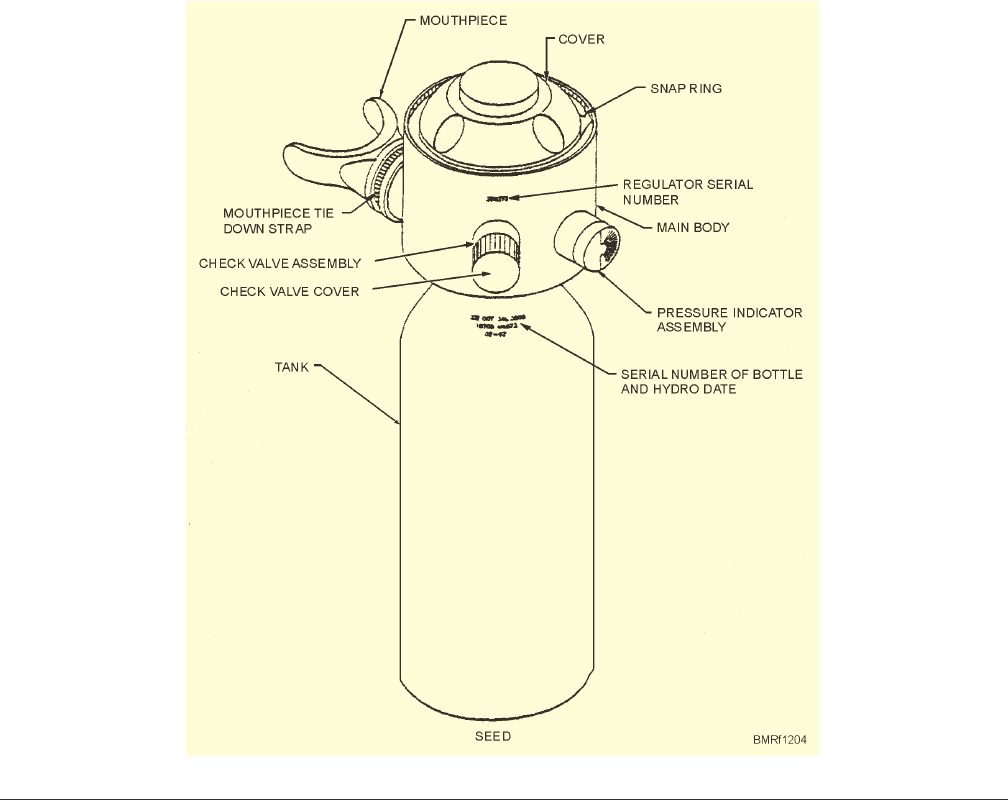
WARNING
EEBDs must not be used for firefighting
purposes.
WARNING
Remember, when donning the EEBD, if you
don’t hear the hissing sound of oxygen being
generated, discard the unit and get another.
DANGER
Don’t smoke immediately after using the
EEBD because your hair is saturated with
oxygen and could catch on fire.
SUPPLEMENTAL EMERGENCY EGRESS
DEVICE (SEED)
Personnel working in engineering spaces wear
supplemental emergency egress devices (SEEDs) on
their belts for easy access. Whenamain spacefire is
calledaway, thewatch stander should use the SEED
(fig. 12-4) to proceed to an EEBD. Thewatch stander
should obtain an EEBD and don it when not in danger
of immediate harm from heat or flames. Because the
SEED lacks protection for the eyes and nose and has a
short operational time, it is a supplemental device.
However, it is immediately available for the
engineering watch standers and is easily operated on
the run. Factors to consider when using these devices
include the following:
12-15
Student Notes:
Figure 12-4.—Supplemental emergency egress device (SEED).
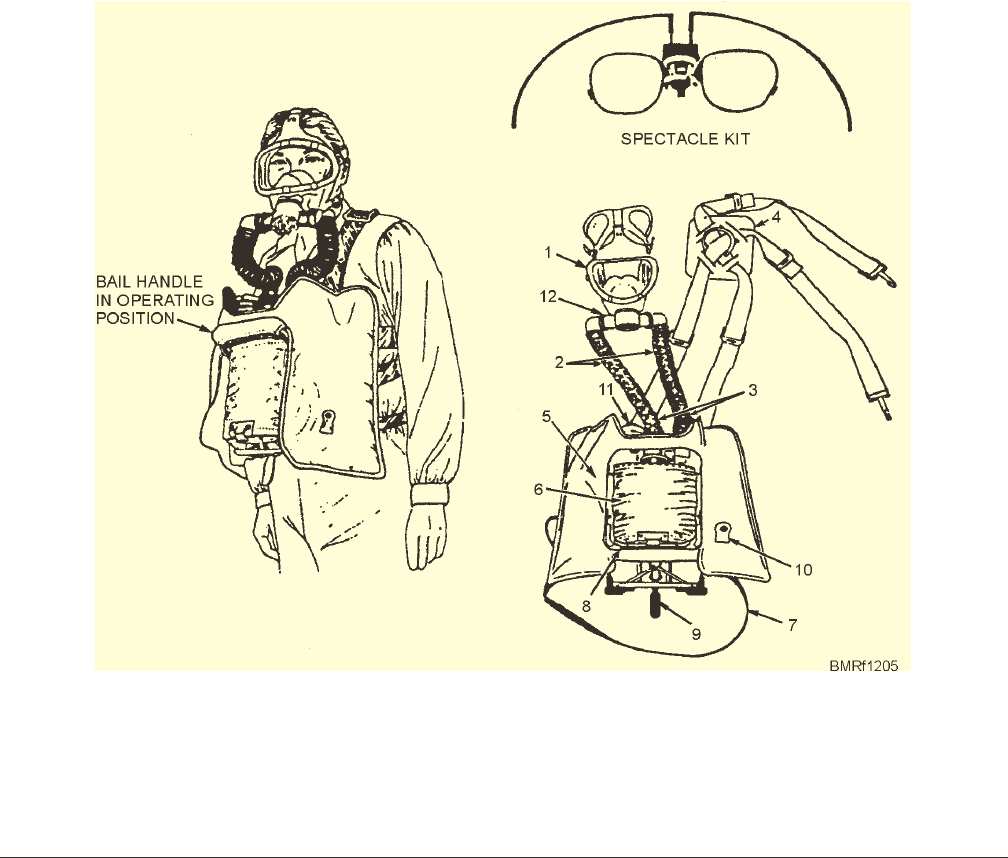
•
How quickly conditions are deteriorating
•
Ease of egress, including travel time to a
breathable atmosphere
•
Operating times for each device
•
Capabilities and limitations of each device
WARNING
Don’t breath through the nose—breath only
through the mouth when using the SEED.
WARNING
SEEDs must not be used for firefighting
purposes.
OXYGEN BREATHING APPARATUS (OBA)
The oxygen breathing apparatus (OBA) (fig. 12-5)
isaself-containeddevicethat generatesoxygenthrough
a chemical process and lets the wearer breathe
independently of the surrounding atmosphere.
Currently, the OBA is the primary tool used by
firefighting teams for respiratory protection. The
effective time limit of the oxygen supply is inexcess of
12-16
Student Notes:
1.
2.
3.
4.
Facepiece
Breathing tubes
Breathing tube couplings
Body harness and pad
5.
6.
7.
8.
Breathing bag
Breastplate
Waist strap
Bail assembly handle
(standby position)
9.
10.
11.
12.
Canister release strap
Pressure relief valve and
pull tab timer
Timer
Valve housing
Figure 12-5.—Navy oxygen breathing apparatus (OBA).
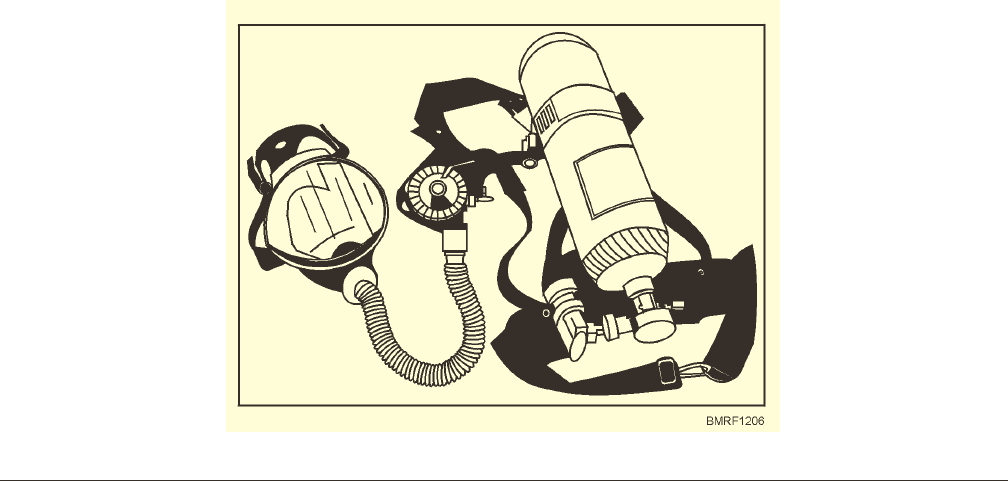
45 minutes.Foryour personnel protection you should
set the timer on the OBA for 30 minutes, allowing
15 minutes to leave the area and return to fresh air.
When in operation, the air within the apparatus is
continuously replenished with oxygen while the
chemicals in the canister remove exhaled carbon
dioxide (CO
2
) andwatervapor. Asaresult of this
chemical action, the OBA wearer may survive andwork
in a toxic atmosphere, such as a smoke-filled
compartment.With thefacepiece and canister in place,
using the OBA formsaclosed self-sustaining system.
For personnel having eyeglasses, a spectacle kit is
availableforthe installation of prescription lenses inthe
facepiece.
WARNING
When removing the candle cover, do not
remove the cotter pinwhile pulling the lanyard.
Removal of the cotter pinfires the candle and
starts generating oxygen. If that happens while
the copper foil is intact, internal pressure in the
canister willbuild up,causing thecopper foil or
canister seam to rupture. Do not pull the cotter
pin until the canister is inserted in the OBA and
the bail assembly is up and locked.
CAUTION
Do not pull the breathing bagtab duringnormal
use because the oxygen in the bags will leak
into the atmosphere, causing loss of your
breathing oxygen.
WARNING
Never allow grease, oil, orwater to enter the
neck of the canister. Any of these liquids may
causeaviolent chemical reaction orexplosion.
The chemicals contained in the canister are
injurious to skin and equipment.
SELF-CONTAINED BREATHING
APPARATUS (SCBA)
The self-contained breathing apparatus (SCBA)
(fig. 12-6) is replacing the OBA throughout the Navy.
The unit’s main components consist of a harness,
high-pressure bottle, pressure regulator, full-face mask,
and the high- and low-pressure hoses as shown below
High-pressure aircylinders arefilled with compressed
gradeDbreathing air and then stored until needed. The
cylinders themselves are rechargeable, replacing the
need for additional canisters in the OBA system.
12-17
Student Notes:
Figure 12-6.—Self-contained breathing apparatus (SCBA).

Once thecylindervalve has been turned on, it
providesacontinuousair supply to the system regulator
via the high-pressure hose. The pressure is reduced by
the regulatorforuse by the wearer, and the low-pressure
hose carries the breathable air into thefacepiece. As a
safety feature, these are positive pressure style
regulators, which means that the air supply to the mask
is just above any demand requirements eliminating any
possibility of toxic fumes from entering the wearer’s
mask.
Thetime eachcylinderlasts willbe determined bya
number offactors. The mainfactors will be the physical
condition and size of the wearer and thework to be
done. Generally, each bottle will last approximately 30
minutes from the time it is activated.
REVIEW 5 QUESTIONS
Q1. How many minutes of air is the EEBD designed
to provide?
Q2. Why should you stayawayfrom open flames
when you first remove an EEBD?
Q3. What should you listen for when donning an
EEBD?
Q4. What device is worn by engineering watch
standers?
Q5. What is the effective time of an OBA?
Q6. When do you pull the cotter pin on an OBA
canister?
FIREFIGHTING
Learning Objectives: When youfinish this chapter,
you will be able to—
•
Recognize the properties ofafire triangle and
fire tetrahedron.
•
Identify the conditions necessary for
spontaneous combustion.
•
Identify the types of heat transfer.
Fire isaconstant threat aboard ship. All possible
measures must be taken to preventafire, or if one is
started, toextinguish it quickly. Fires may start from
several causes—spontaneous combustion,
carelessness, hits by enemy shells, or collision. If the
fireis notcontrolled quickly, it may cause moredamage
than the initial casualty and could cause the loss of the
ship.
FIRE AND FIREFIGHTING
You cannot win againstafire.Youcanfight thefire
and you can hold down its damage;butsome property
will be destroyed and, all too often, people will be
injuredorkilled.Timeisalwayslost,productive workis
stopped,andadditional effortand materials are required
to make repairs and to clean up the mess.
The objective offire prevention, therefore, is to
prevent fires from starting. Fire prevention is an
all-hands, all-day, all-night, heads-up effort.Acigarette
tossedin the wrongdirectioncan causeasmuchdamage
asanenemy bomb. An oilywipingragorasparkingtool
can be as dangerous as an open flame inagasoline
depot.
Each ship is required to institute and maintainafire
prevention program.Your part in thefire prevention
program is as follows:
•
Ensure that all gear is stowed properly.
12-18
Student Notes:
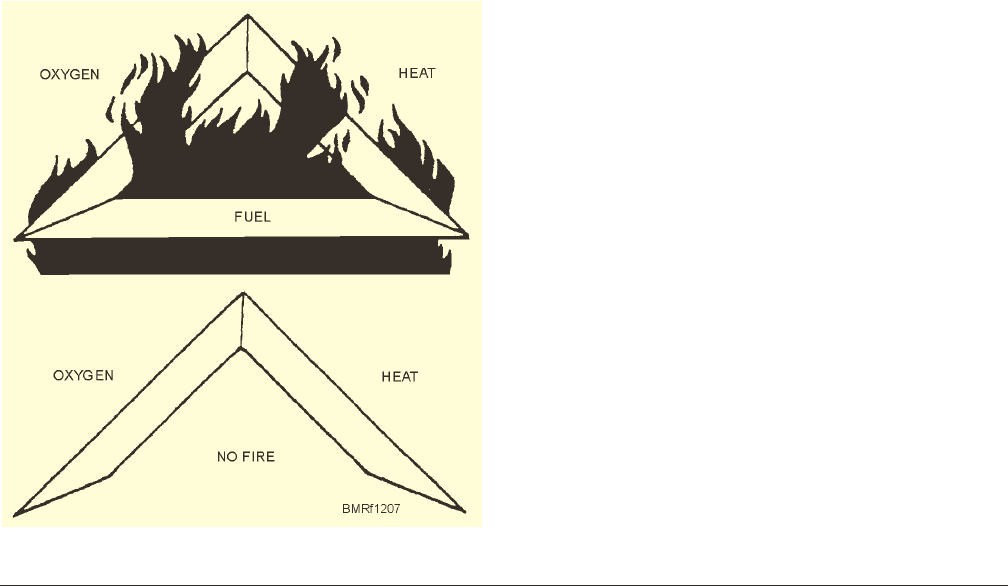
•
Practice good housekeeping procedures, such as
the daily removal of trash from spaces.
•
Practice safety precautions whenworking with
flammable materials.
•
Report all potential fire hazards.
•
Keepfirefighting equipment handy and in good
working order.
•
Ensure closures and fittings are working
properly and report any discrepancies.
FIRE TRIANGLE
The entire chemistry and physics of fire and
burning, or combustion, can be simplified into a
relationship between three components—fuel, heat
(temperature), and oxygen (air).Tohaveafire in any
combustible substance, each one of these components
must be present to help each other. Picture these
components in the form ofatriangle, as shown infigure
12-7.
Look atfigure 12-7. Here, you can see that if the
oxygenreacts with thefuel,it creates heat,whichcauses
a draft or some other condition that takes in more
oxygen and creates still more heat, and so on. Or the
heat may cause more fuel to becomeavailable (such as
causinggasoline to boil intovapor), which then takes
more oxygen toburn and creates more heat, which then
producesstill morefuel,andsoon. Theburningreaction
can go in many different directions.
The modern science of firefighting and fire
extinguishment is based on the sides of thefire triangle
and an uninhibited chain reaction of burning.
Obviously, thefirefightercanremove one or more of the
components to cause theburning to stop. The type of
firefighting agent thefirefighter has at hand determines
which component or components of the triangle will be
removed.
Anotherwaythefirefightercanstop thefire(andthe
combustion) is to place a screen between any two
components of the triangle. If thefighter uses an agent
asatemporary screen that breaks the triangle, thefire
goesout.Obviously, thefirecan quickly startupagainif
this method is used because each of the three necessary
components is still therewaiting to start thefire again
once the screen is gone.
FIRE TETRAHEDRON
Thefire triangle describes the requirements for
surface glowing or smoldering, but it doesn’t
completely describe flaming combustion requirements.
A fourth requirement, an uninhibited chain reaction, is
needed for flames toexist. This is shown by thefire
tetrahedron (fig. 12-8).Atetrahedron isasolidfigure
with four triangularfaces. It is useful for illustrating the
flaming combustion process because it provides for the
chemical chain reaction requirement and each face
touches the other three sides. As described for thefire
triangle, flaming combustionstops whenone of thefour
sides of the fire tetrahedron is removed.
SPONTANEOUS COMBUSTION
Fire, also called burning or combustion, isarapid
chemical reaction that results in the release of energy in
the form of light and heat. Most spontaneous
combustion involvesvery rapid oxidation; that is, the
12-19
Student Notes:
Figure 12-7.—Requirements for combustion.
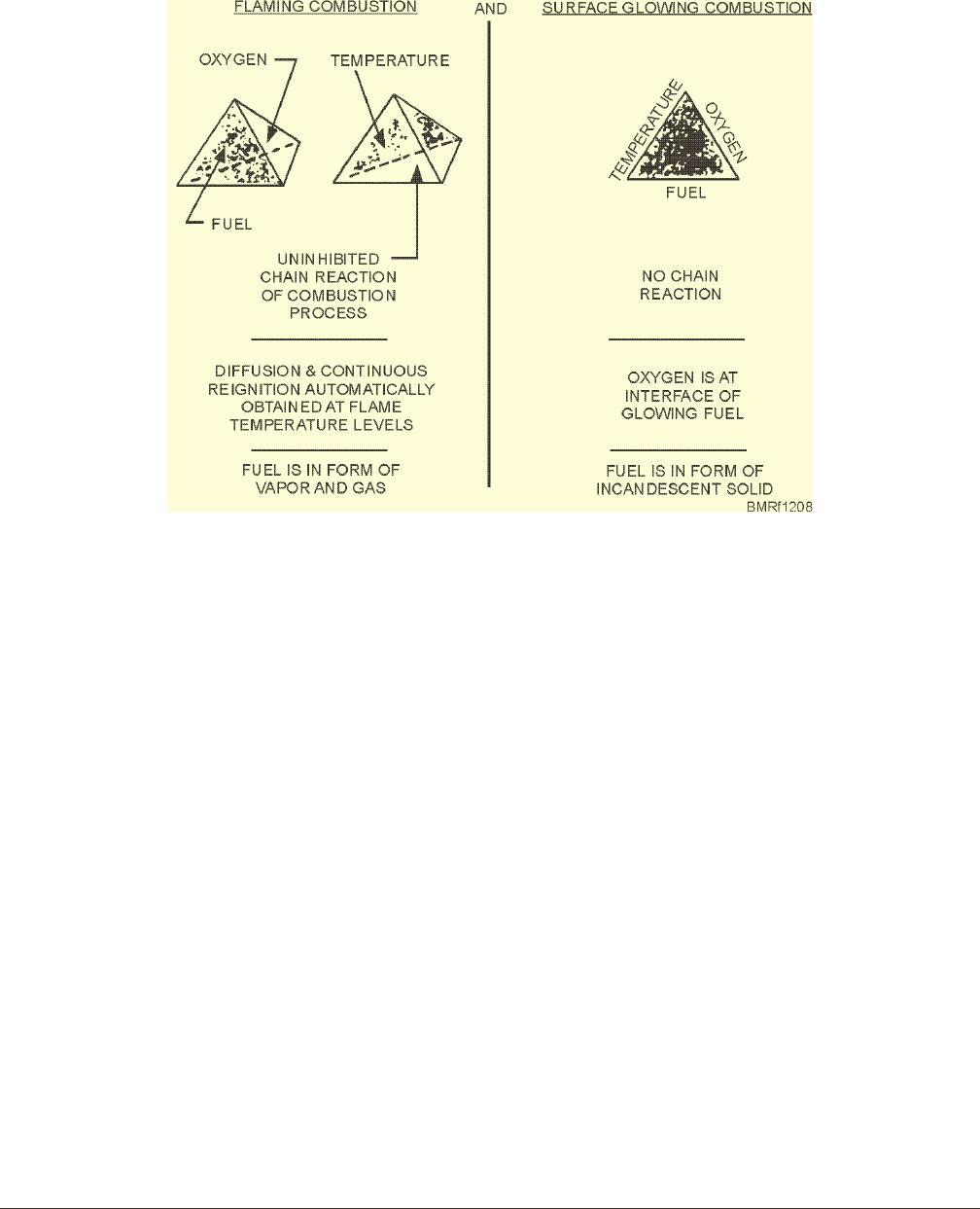
chemical reaction by which oxygen combines
chemically with the burning material.
Such things as rags or paper soaked with oil or with
paints or solvents are particularly subject to
spontaneous combustion if they are stowed in confined
spaces where the heat caused by oxidation cannot be
dissipated rapidly enough.
Afire involving combustible fuel or other material
must have an ignition source, and the material must be
hot enough toburn. The lowest temperature at which a
flammable material gives off vaporsthatwillburn when
a flame or spark is applied is called the flash point. The
fire point, whichisusuallyafew degreeshigherthan the
flash point, is the temperature at which the fuel will
continuetoburn after it has been ignited.Theignitionor
self-ignition point is the lowest temperature to which a
material must be heated to give off vapors that willburn
without the aid ofaspark or flame. In otherwords, the
ignition point is the temperature at which spontaneous
combustion occurs. The ignition point is usually at a
much higher temperature than the fire point.
METHODS OF HEAT TRANSFER
Heat fromafire is transferred by one or more of the
following methods:
1. Conduction
2. Convection
3. Radiation
Conduction
Conduction is the transfer of heat throughabody or
from one body to another by directphysical contact.For
example, onahot stove, heat is conducted through the
pot to its contents.Wood is ordinarilyapoor conductor
of heat,butmetals are good conductors. Since most
ships are constructed of metal, heat transfer by
conduction isapotential hazard. Fire can move from
onefire zone to another, one deck to another, and one
compartment to another by heat conduction.
Often, the skillful application ofwater, using fog
patternstorapidlycoatandrecoatsurfaceswithafilmof
water, will slow or halt the transmission of heat by
conduction.Fogpatterns coat surfaces more efficiently
12-20
Student Notes:
Figure 12-8.—Tetrahedron and fire triangle.

than solid streams, reducing run off and the effect on
ship stability.
Convection
Convection is the transfer of heat through the
motion of circulating gases or liquids. Heat is
transferred by convection through the motion of smoke,
hot air, and heated gases produced by a fire.
When heat is confined (as withinaship), convected
heat moves in predictable patterns. Thefire produces
lighter than airgases that rise toward high parts of the
ship. Heated air, which is lighter than cooler air, also
rises. As these heatedcombustion products rise, cool air
takes their place; the cool air is heated, in turn, and then
rises to the highest point it can reach.
Hot smoke originating atafire onalow deck will
travel horizontally alongpassageways, and then upward
by way of ladder and hatch openings, heating
flammable materials in its path.Topreventfire spread,
release the heat, smoke, andgases to the atmosphere.
However, the structural design of a ship makes it
difficult to rapidly cut openings through decks,
bulkheads, or the ship’s hull for ventilation. It is
imperative that thefire be confined to the smallest
possible area. Doors and hatchways should bekept
closed when they are not in use. Ifafire is discovered,
attempts should be made to close off all openings to the
fire area untilfirefighting personnel and equipment can
be brought into position to fight the fire.
Radiation
Heat radiation is the transfer of heat fromasource
across an intervening space; no material substance is
involved. The heat travels outward from thefire in the
same manner as light; that is, in straight lines. When it
contactsabody, it’s absorbed, reflected, or transmitted.
Absorbed heat increases the temperature of the
absorbing body. For example, radiant heat that is
absorbed by anoverhead will increase the temperature
of that overhead, perhaps enough to ignite its paint.
Heat radiates in all directions unless it’s blocked.
Radiant heat extends fire by heating combustible
substances in its path, causing them to producevapors,
then igniting the vapor.
Withinaship, radiant heat raises the temperature of
combustible materials near thefire and, depending on
the ship’s design, at quite some distance from thefire.
Shipfires can spread asaresult of radiatingbulkheads
and decks. Intense radiated heat can make an approach
to thefireextremely difficult.Forthis reason,protective
clothing should be worn by firefighters.
REVIEW 6 QUESTIONS
Q1. Fire prevention is the responsibility of—
Q2. List the three components that make up a fire.
a.
b.
c.
Q3. What process is involved in most cases of
spontaneous combustion?
Q4. List the three methods of heat transfer.
a.
b.
c.
CLASSES OF FIRE
LearningObjective: When youfinish this chapter, you
will be able to—
•
Recognize the four classifications offire and
identify the means used to extinguish them.
Fires are divided into four classifications, each
indicating the type of materialburning. By knowing the
12-21
Student Notes:

class offire, the primary agent and best method for
extinguishing thefire can be determined as shown in
figure 12-9.
Many substances,such as liquids,gases, and solids,
are used asfirefighting agents. The selection and use of
theseagentsvarieswiththe classoffire,itslocation,and
theextent of thefire involvement. Although seawater is
the mostvaluablefirefighting agentavailable based on
its endless supply, considerations should always be
takentodetermineifwateristhe bestagent toputoutthe
type of fire being fought.
REVIEW 7 QUESTIONS
Q1. Match the class offirewiththe types of materials
involved.
12-22
Student Notes:
CLASSES OF
FIRE
TYPES OF MATERIALS
INVOLVED
METHOD(S) OF EXTINGUISHING
A
Wood and wood products,
cloth, textiles and fibrous
materials, and paper and
paper products.
Water in straight or fog pattern. If the fire is deep-seated,
aqueous film forming foam (AFFF) is more effective than
seawater and can be used as a wetting agent.
B
Flammable liquids, such as
gasoline, diesel fuel (F-76),
jet fuels, hydraulic fluid, and
lube oil. Also, involves
flammable gases.
Extinguished with AFFF, Halon 1211, Halon 1301, or
potassium bicarbonate (PKP). Never extinguish flammable
gases unless there is a good chance that the flow of gas can
be secured. Securing the flow of gas is the single most
important step in controlling a gas fire.
C Energized electrical fires.
Use nonconductive agents, such as CO
2
, Halon 1211, or
water spray. Most effective tactic is to de-energize and
handle the fire as a class A fire. If fire isn’t deep-seated,
clean agents that don’t a cleanup problem are preferred
(CO
2
or Halon 1211).
D
Combustible metals, such as
magnesium and titanium.
Water in quantity, using fog patterns. When water is
applied to burning class D materials, explosions may occur.
Apply water from a safe distance or from behind shelter.
Figure 12-9.—Classes of fire.
MATERIALS CLASSES OF FIRE
a. Hydraulic fluid A
b. Energized circuit board B
c. Paper C
d. Gasoline D
e. Magnesium
f. Cloth
g. Titanium
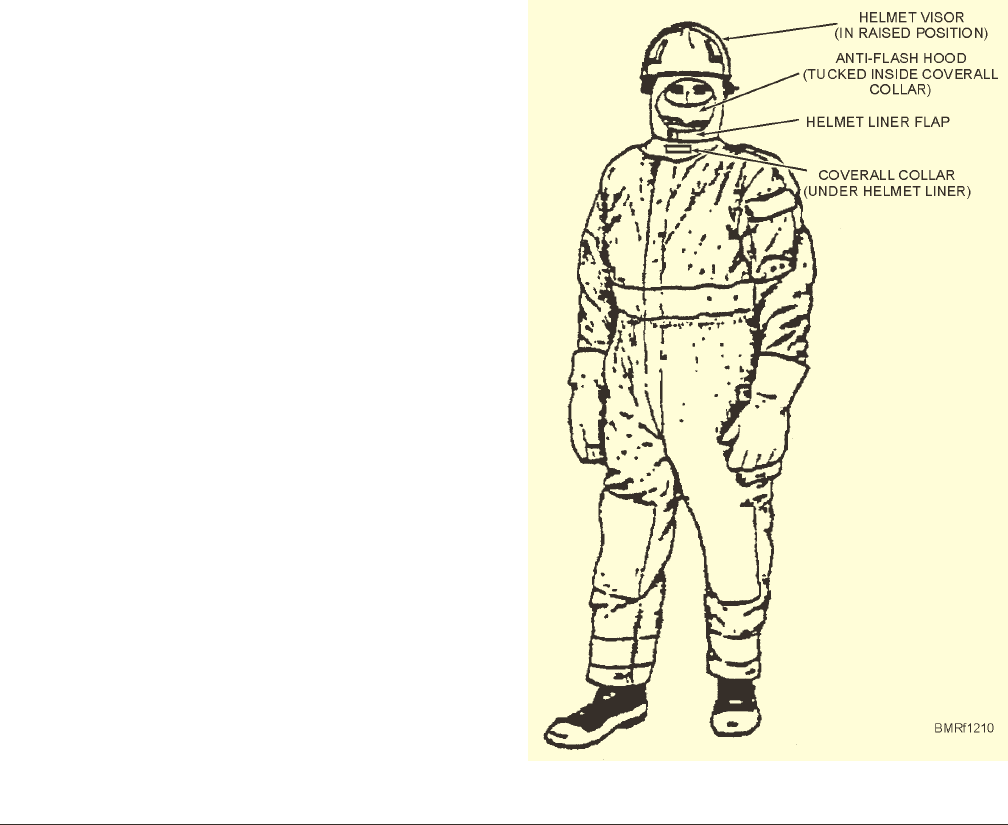
Q2. What is the mostavailable heat-removing agent
for shipboard use?
Q3. AFFFwasdeveloped to combat what class of
fire?
Q4.
CO
2
is the primary agent to disrupt the fire
triangle of what class fire?
Q5. Whatisaneffective agentagainstaclassDfire?
DAMAGE CONTROL EQUIPMENT
LearningObjective: Whenyoufinish this chapter, you
will be able to—
•
Identify the portable equipment and fixed
systems that make up the shipboard inventory of
protection equipment.
As you’ve learned in this chapter, damage control is
anallhands job. Thetime ittakesto getafireor flooding
under control is vital.Youshould becomefamiliar with
the portable equipment andfixedsystems that make up
your ship inventory of protection equipment. Because
of the large amount ofexplosives, fuels, and other
flammablematerialsaboard ship, you must know where
equipment is located and how to use it before an
emergency exists.
Knowing where equipment is and how to use it
applies not only tofirefighting equipmentbutalso the
equipment used for flooding or CBR protection. The
equipment and its storage locationvaries from ship to
ship, so you must know your ship.
You mayfind yourself thefirst person on the scene,
so knowing the basic rules of damage control and
equipment usage may make the difference in the loss of
many spaces orashipmate’s life. Perhaps you will be
called to serve onafire party or flooding detail. As a
team member, keep in mind, the lack of equipment and
procedures could result in a disastrous outcome.
Figures 12-10 through 12-15 show someexamples
of the equipment that’s common to all ships. These
figures show onlyasmall amount of what you’llfind in
a ship’s repair locker.
THE FIREFIGHTER ENSEMBLE
Thefirefighter’s ensemble (fig. 12-10) is used to
protect thefirefighter from short duration flame (flash)
exposure, heat, and falling debris.
12-23
Student Notes:
Figure 12-10.—Firefighter’s ensemble.
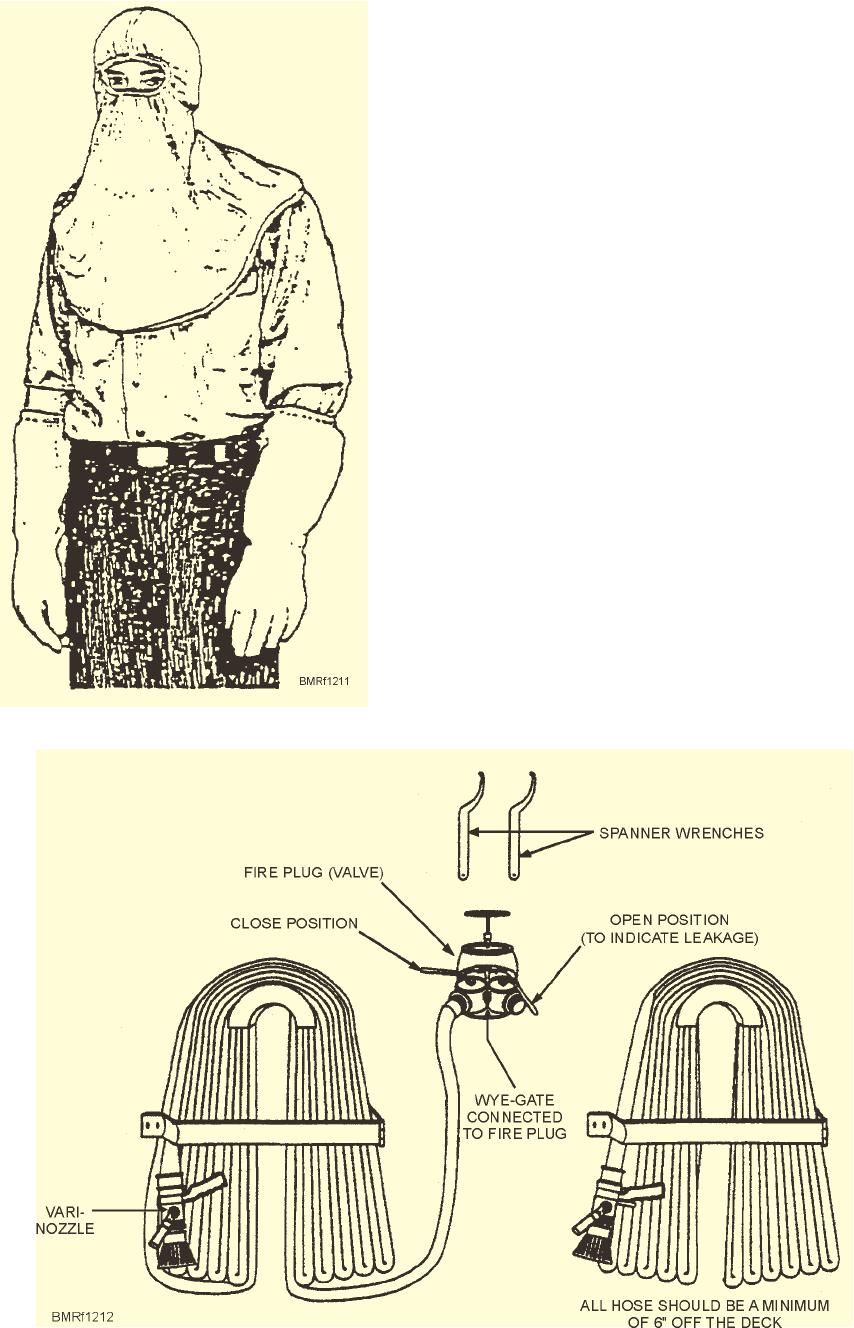
ANTI-FLASH CLOTHING
Anti-flash clothing (fig. 12-11) is used to protect
personnel from high temperatures resulting from the
useofexplosive weapons andfromburnscaused byfire.
The clothing consists of the following two items:
1. Anti-flash hood
2. Anti-flash gloves
FIRE HOSE STATION
A fire hose station (fig. 12-12) is commonly
referred to as either a fire station or a fireplug. Thefire
hose station is the location ofafireplug and associated
equipment. Branches of thefiremain system supply
water to thefire hose stations throughout the ship.
Generally, fire hose stations aboard frigates and larger
ships have 1 1/2-inchfireplugs andfire hose stations
aboard ships larger than frigates have 2 1/2-inch
fireplugs.
P-100 PUMP
The P-100 pump is a diesel-engine-driven
portable pump unit. It’s designed for firefighting (fig.
12-13) and limited dewatering (fig. 12-14) functions
aboard ships.
12-24
Figure 12-12.—Fire hose station.
Figure 12-11.—Anti-flash clothing.
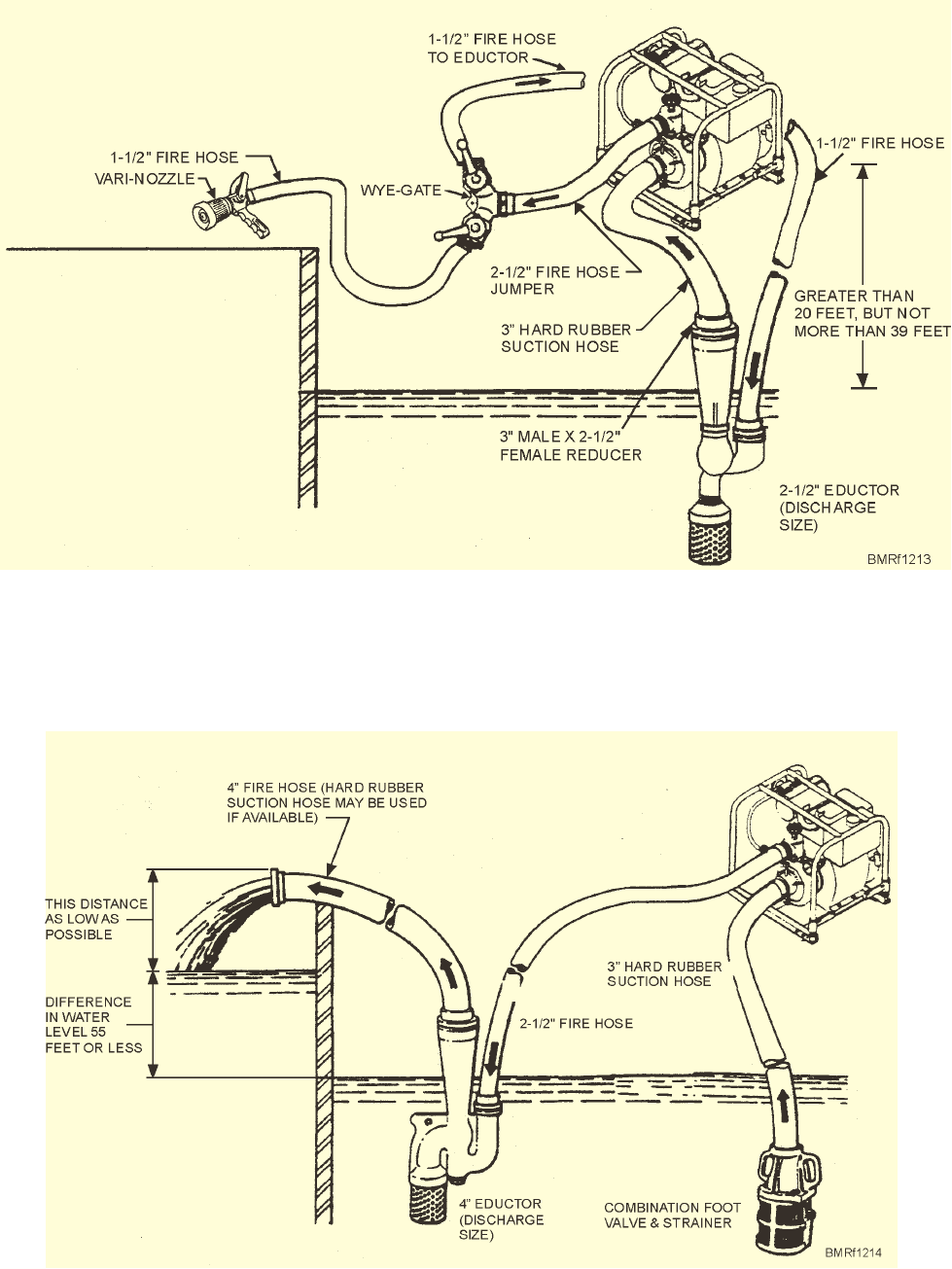
12-25
Figure 12-14.—Dewatering hookup.
Figure 12-13.—Firefighting hookup.
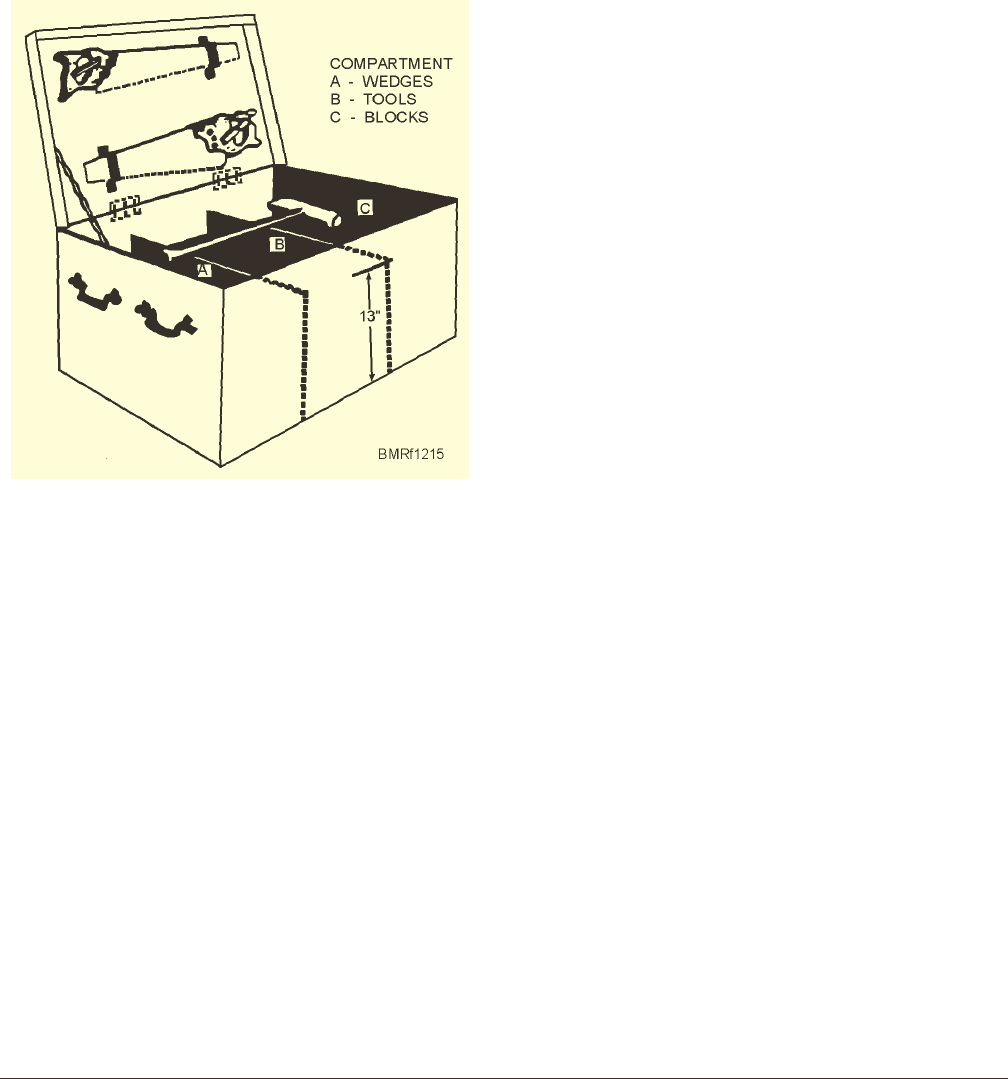
DAMAGE CONTROL SHORING CHEST
Each repair station hasadamage control shoring
chest (fig. 12-15). The chest is divided into three
compartments to separate the different tools and
materials needed for shoring.
REVIEW 8 QUESTION
Q1. Describe the purpose of the following items.
a. Damage control shoring chest
b. P-100 pump
c. Firefighter ensemble
d. Anti-flash clothing
e. Fire hose station
SUMMARY
A ship lives or dies depending on its crew’s ability
to combat a wide range of casualties, and these
casualties are not restricted to times of conflict.
Casualties can occur while moored in your homeport,
at anchorageoverseas, or duringaroutine peacetime
deployment. The requirement for every person on
board, from the commanding officer to thefireroom
messenger, to have a good,basic knowledgeof damage
control procedures and constant training and drills in
combating shipboard casualties is essential to the
ship’s survival. This training and preparation
demonstrated during the Persian Gulf crisis saved
several U.S. Navy ships that sustained considerable
damage. If these crews had not been trained in damage
control, these ships and most likelyalarge portion of
their crews may have been lost.
The proper use of the closure log is just as
important as knowing how to don an OBA or useafire
hose. Thebusiness of damage control is serious. Learn
it well; your life, the lives of your shipmates, and your
ship depend on it.
REVIEW 1 ANSWERS
A1. The damage control organization is divided into
the—
a.
Administrative organization
b.
Battle organization
A2. The purpose of the administrative phase of DC
is to establish and maintain material
readiness conditions.
A3.
The engineer officer is responsible for
maintaining properly trained DCPOs, repair
parties, and repair locker personnel.
A4.
The XO is the senior person assigned as team
leader on DCTT.
12-26
Figure 12-15.—Damage control shoring chest.
Student Notes:
A5.
The DCPO is responsible for making sure that
all battle lanterns, dog wrenches, spanners, and
other damage control equipment are inplace and
in a usable condition within their division.
A6. Beforeanyoneentersapoorlyventilatedspaceor
void, the gas free engineer (GFE) certifies the
space as safe.
REVIEW 2 ANSWERS
A1.
The battle phase of damage control starts when
the ship receives actual damage.
A2.
The battle station for the DCA is DCC/CSS.
A3. DCC receives reports and casualty status from
repair parties.
A4. Theminimumrequirement to beamember of the
in-port emergency team is to be repair party
qualified.
A5. The primary missions of the rescue and
assistance team are to assist persons from the
water, other units in distress, and other
persons or activities in distress ashore.
A6.
General quarters is the highest state of
readiness.
REVIEW 3 ANSWERS
A1. The X40J circuitry is commonly referred to as
the salt and pepper line.
A2. The alarms that canoverride the microphone
control of the IMC are the
a.
Collision
b.
Chemical attack
c.
General
d.
Flight crash
A3. When all communications systems fail,
messengers are used to deliver messages and
orders between repair lockers and DCC.
REVIEW 4 ANSWERS
A1. Survivability of the ship can be ensured by
compartmentation.
A2. The three basic material readiness conditions
are—
a.
XRAY
b.YOKE
c.
ZEBRA
A3.
Material condition XRAY provides the least
amount ofwatertightness.
A4.
Normally, YOKE is set at sea and in port during
wartime.
A5.
Material condition ZEBRA is set when GQ is
sounded.
A6.
DOG ZEBRA fittings are closed to set darken
ship.
A7. To find a list of all DC fittings within a
compartment, you should refer to the
compartment checkoff list.
REVIEW 5 ANSWERS
A1.
The EEBD is designed to provide 15 minutes of
air.
A2.Youshould stayawayfrom open flames when
youfirst remove an EEBD becauseyour hair is
saturated with oxygen and could catch fire.
A3. When donning an EEBD, you should hear a
hissing sound.
A4.
Engineering watch standers wear a SEED.
A5.
The effective time of an OBA is 45 minutes.
A6.
You pull the cotter pin on an OBA after the
canister has been inserted in the OBA and
locked in place.
REVIEW 6 ANSWERS
A1.
Firepreventionisthe responsibilityof allhands.
A2. Thethreecomponentsthatmakeupafireare—
a.
Heat
b.
Fuel
c.
Oxygen.
12-27
A3. Most cases of spontaneous combustion involve
the process of rapid oxidation.
A4. The three methods of heat transfer are—
a.
Conduction
b.
Radiation
c.
Convection
REVIEW 7 ANSWERS
A1.
A2.
Sea water is the mostavailable heat-removing
agent for shipboard use.
A3.
AFFFwas developed to combat class B fires.
A4.
CO
2
is the primary agent to disrupt thefire
triangle of class C fires.
A5.
Waterfog is an effective agent againstaclass D
fire.
REVIEW 8 ANSWERS
A1. The purposes of the following items are as
follows:
a.
Damage control shoring chest. A chest thatis
divided into compartments for storing
materials used for shoring.
b.
P-100 pump. The P-100 pump can be used
to fight fires or to dewater spaces.
c.
Firefighter ensemble. The firefighter
ensemble protects personnel from short
duration flames, heat, and falling debris.
d.
Anti-flash clothing. Anti-flash clothing
protects personnel from heat caused by
high explosive weapons and fromburns
caused byfire.There are two items that
make up anti-flash clothing—anti-flash
gloves and the anti-flash hood.
e.
Fire hose station. Thefire hose station is
where the fireplug and associated
equipment is located.
12-28
MATERIALS CLASSES OF FIRE
a. Hydraulic fluid
B
b. Energized circuit board
C
c.Paper
A
d. Gasoline
B
e. Magnesium
D
f. Cloth
A
g.Titanium
D
